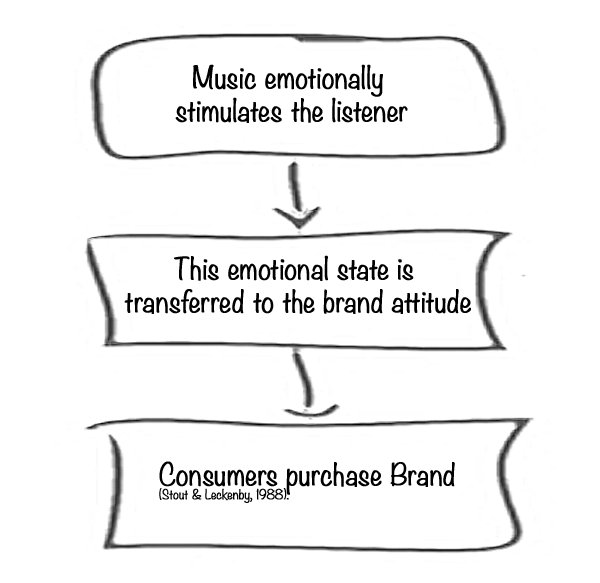How do I choose the right music?
As a videographer, advertising firm, or image consultant, you are choosing music with the hope of influencing customers through advertising. You first must understand how customer’s purchase. A customer’s purchase is both cognitive and emotional. When you select music, you are trying to influence or enhance the emotional connection a viewer has with your product or service. Research shows that music can positively affect or emotionally engage your listener (Morris and Boone 1998). Customers can transfer this pleasurable emotional experience to the product’s brand. This may affect your customer’s brand attitude and lead to a brand purchase. (Rossiter & Percy 1991)
For example, the customer who sees an ad for all natural greek yogurt might not run out and buy it at the time of seeing the commercial. However, if the customer emotionally connects with the branding image of all natural greek yogurt, they may become brand loyal next time they shop.
Here is the advertiser’s dream:

Knowing this, let’s look at Budweiser’s “Puppy Love” Super Bowl spot rated as the number one effective commercial in 2014 published in ADWEEK.
First let’s think of the emotional connection possibilities with beer. People might need an alcoholic drink to socialize with friends or to unwind at the end of the day. These can all be pleasurable experiences, but, what if they are negatively interpreted? What if the social situation is interpreted as too rowdy and dangerous. What if the businessman is perceived as lonely and depressed. It is too risky so the company creates a new emotional connection.
This connection has nothing to do with actually drinking the beer. It has to do with being socially responsible and acquiring a social identity of getting back to all natural, organic products. The advertisement doesn’t tout all the advantages of their beer product. It tastes better, costs less, has fewer calories, whatever they may be. It raises a social need or awareness and associates the Budweiser brand as a solution.
Here is what you see:
- Puppies needing adopting.
- A puppy bonding with a clydesdale horse that is associated with Budweiser.
- A love relationship blooms between the puppy and the horse.
- An all natural, organic setting on the farm.
The word Budweiser at the end of the commercial.
Step 1: Brilliant! You are emotionally moved or stimulated.
Step 2: You transfer your emotions of sweet, all natural, organic, socially responsible, animal lover feelings to Budweiser brand.
Step 3: You are in the aisle of your grocery store and buy the brand that you have warm and fuzzy feelings toward.
Budweiser has taken a product that can have negative connotations and made it a socially responsible, loving, all natural product.
How does Music enhance this commercial?
Try watching the commercial with and without music to get the full impact.
Here is what you hear:
- An warm and inviting acoustic guitar and piano melody that sets the mood for a more rustic, all natural setting
- Lyrics singing about letting a lover go (never mind it’s a horse )
- Lyrics singing about missing home and appreciating something only when it is gone.
- A soft acoustic melody that is perfectly timed with longing puppy shots and tender moments between the puppy and horse
- The acoustic guitar melody picks up intensity as well as musical instruments and background vocals are added at the point of a Clydesdale horse racing after the puppy.
- You see a story unfold from a soft beginning to a dramatic end. The music helps create the intensity of this by a soft acoustic beginning to a dramatic multi-musical instrument climax.
How do you choose the right music for your project?
You might ask yourself the following questions as you pick out your music.
Does the music make the right emotional connection with the audience?
Does my advertisement have a voice over or not? If there is a voice over, you will need an instrumental song only.
How well does the music fit with the photograph in the advertisement? Does the tempo of the song fit the picture changes and climax of the story told through the pictures. How well does the music fit with the headlines in the advertisement? How well does the music fit with something specific mentioned about the brand (or cause) in the copy? How well does the music fit with the overall benefit of the brand or cause? How does the music in the ad further project the brand image of my product or service ( MacInnis and Park, 1991).
Does my ad tell a story? Does my music tell a story along with the ad? Is there a beginning, middle and end to it?
Is your product hip and trendy? Can you choose an equally hip and trendy artist or musical sound? Is your demographic audience familiar with this song or sound? Has it been featured in a well known film, video, or commercial that would increase their chances of seeing your product in a positive view.
Is the song a sound alike for a popular artist that would help further your cause. Can you transfer the artist’s popularity to your product?
If your demographic is the elderly, can you choose a vintage song that conjures up pleasurable memories.
If your brand image is all natural and organic can you choose an equally natural sounding music accompaniment like an acoustic song?
To browse music that will make an emotional connection with your audience visit RoyaltyFreeGuru.com.
Sources:



